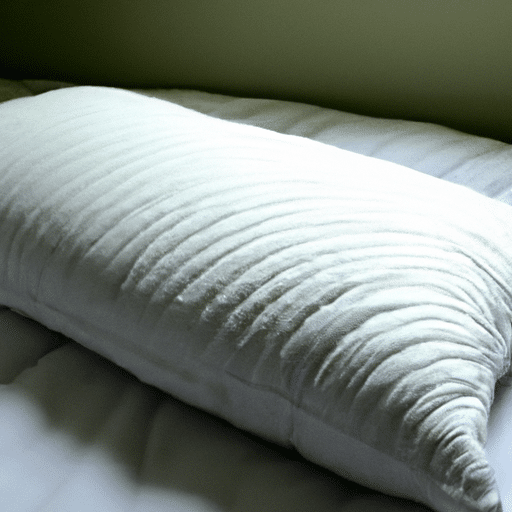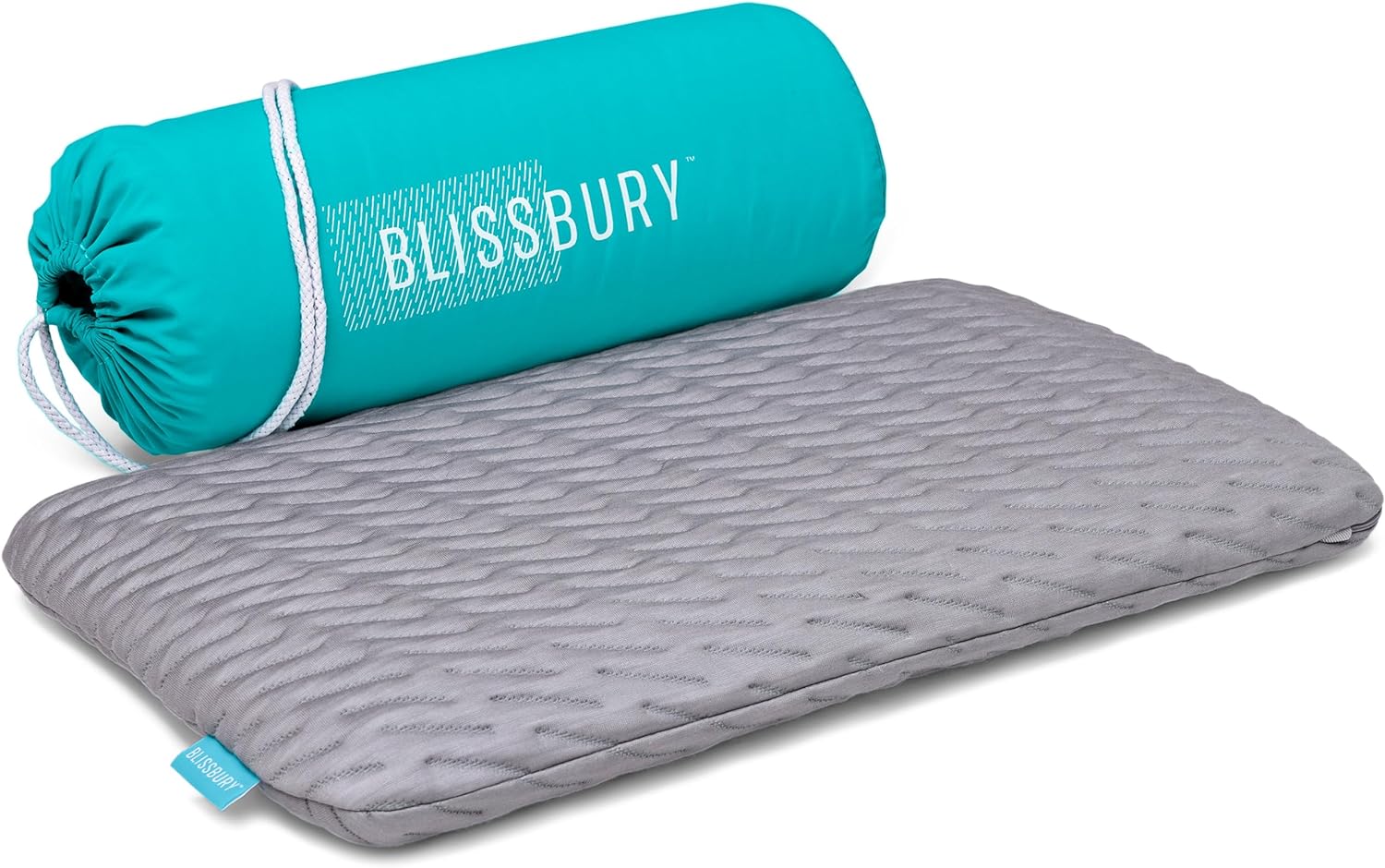Are you tired of waking up with aches and pains in your back? Look no further! In this article, we will explore the incredible benefits of using a body pillow to relieve back pain. From providing optimal spinal alignment to reducing pressure points, a body pillow can be the ultimate solution for a good night’s sleep. Say goodbye to discomfort and hello to sweet dreams as we delve into the numerous advantages of incorporating a body pillow into your bedtime routine. Get ready to experience the blissful relief that a body pillow can bring to your back!
Review contents
What is a body pillow?
Definition of a body pillow
A body pillow is a large, elongated pillow that provides support and comfort to the entire body. Unlike regular pillows that are designed for the head and neck, a body pillow spans the entire length of the body, offering support to the back, hips, legs, and arms. It is typically made of soft and pliable materials, with a shape that conforms to the natural curves of the body. Body pillows come in various sizes, shapes, and materials to cater to individual preferences and specific needs.
Different types of body pillows
There are several different types of body pillows available in the market, each designed to target specific areas of the body or provide particular benefits. Some common types of body pillows include:
-
Straight body pillows: These are long and cylindrical in shape, resembling a traditional bolster pillow. They can be used to support the back, hips, and legs, and are particularly beneficial for side sleepers or individuals who require extra support during pregnancy.
-
U-shaped body pillows: U-shaped body pillows provide support to both sides of the body simultaneously. They are ideal for individuals who sleep on their sides and require support for the head, neck, back, and legs simultaneously.
-
C-shaped body pillows: C-shaped body pillows are designed to wrap around the body, providing support to the back, legs, and neck. This type of pillow is especially useful for pregnant women, as it helps alleviate pressure on the lower back and pelvic area.
-
J-shaped body pillows: J-shaped body pillows are similar to C-shaped pillows, but with a slightly different design. They offer support to the back and legs, and the extended hook-shaped end can be used to prop up the head and neck.
-
Wedge body pillows: Wedge body pillows are triangular in shape and are commonly used to elevate specific body parts such as the legs, back, or head. They are often recommended for individuals with specific medical conditions or injuries.
How body pillows can be used for various purposes
While body pillows are primarily known for providing support and relief from back pain, they can also be used for various other purposes. Some common uses of body pillows include:
-
Pregnancy support: Body pillows are highly beneficial for pregnant women, as they offer support to the growing belly, alleviate pressure on the lower back and hips, and help maintain a comfortable sleeping position.
-
Post-surgery recovery: After undergoing surgery, certain body parts may require additional support or elevation. Body pillows can be used to prop up the legs, back, or arms, providing relief and aiding in the recovery process.
-
Relaxation and comfort: Body pillows offer a sense of comfort and relaxation, allowing individuals to create a cozy and supportive environment for reading, watching television, or simply lounging during the day.
-
Travel companion: Body pillows can be a great travel companion, especially on long journeys or flights. They provide a comfortable resting surface and can help individuals maintain a proper posture while seated.
-
Physical therapy aid: Body pillows are often used in physical therapy sessions to support and align the body during exercises or stretches. They help improve stability, enhance posture, and aid in the recovery from injuries.
By understanding the different types of body pillows and their various uses, individuals can choose the one that best suits their needs and preferences.
Understanding back pain
Causes of back pain
Back pain is a common ailment that can be caused by a variety of factors. Some common causes of back pain include:
-
Muscle strain: Overusing or exerting the muscles of the back can lead to muscle strains or sprains, resulting in pain and discomfort.
-
Poor posture: Maintaining improper posture for prolonged periods, such as slouching or hunching over, can put strain on the back muscles and lead to pain.
-
Spinal abnormalities: Conditions such as scoliosis, herniated discs, or spinal stenosis can cause structural abnormalities in the spine, leading to back pain.
-
Injury or trauma: Accidents, falls, or sports-related injuries can cause acute or chronic back pain.
-
Lifestyle factors: Sedentary lifestyle, lack of exercise, obesity, and poor ergonomics can contribute to back pain.
Types of back pain
Back pain can be categorized into two main types:
-
Acute back pain: Acute back pain refers to pain that lasts for a short duration, typically a few days to a few weeks. It is usually caused by sudden injuries or muscle strains and can be managed through rest, pain medication, and lifestyle modifications.
-
Chronic back pain: Chronic back pain refers to pain that lasts for more than three months or recurs frequently. It can be caused by underlying medical conditions or structural abnormalities. Chronic back pain may require medical intervention, including physical therapy, medication, or surgery, depending on the severity and cause of the pain.
Impact of back pain on daily life
Back pain can significantly impact an individual’s daily life, affecting their ability to perform routine activities. The consequences of back pain may include:
-
Sleep disturbances: Back pain can make it challenging to find a comfortable sleeping position, leading to disrupted sleep patterns and fatigue.
-
Reduced mobility: Severe back pain can limit mobility and prevent individuals from engaging in physical activities or performing household chores.
-
Emotional distress: Constant pain and discomfort can take a toll on an individual’s mental and emotional well-being, leading to stress, anxiety, and depression.
-
Impact on work: Back pain can affect productivity and performance at work. It may also result in missed days or difficulty in carrying out work-related tasks.
Understanding the causes, types, and impact of back pain highlights the importance of finding effective ways to alleviate and manage this condition. Body pillows are an excellent tool that can provide relief and support for individuals experiencing back pain.
How body pillows help alleviate back pain
Proper alignment and support
One of the key benefits of using a body pillow for back pain is the promotion of proper alignment and support. The ergonomic design and length of body pillows allow for better alignment of the spine, reducing strain on the back muscles, and providing support to the natural curvature of the body. By keeping the spine in a neutral position, body pillows help alleviate back pain and promote better posture during sleep or relaxation.
Reduction of pressure points
Back pain can be exacerbated by the presence of pressure points, which occur when certain areas of the body bear excessive weight or discomfort due to poor posture or inadequate support. Body pillows help distribute body weight evenly, thereby reducing the formation of pressure points and relieving pain. By providing support to the back, hips, and legs, body pillows minimize the strain on specific areas, encouraging better blood circulation and reducing the risk of pressure-related discomfort.
Maintaining spinal curvature
The natural curvature of the spine plays a crucial role in spinal health and proper alignment. Body pillows are designed to mimic the contours of the body and provide support to maintain the natural curvature of the spine during sleep. This helps avoid excessive strain on the back muscles and supports the vertebrae, alleviating back pain and promoting spinal health.
Distribution of weight
Body pillows excel at distributing the weight of the body, ensuring that no single area bears excessive pressure or strain. By providing support to the entire body, body pillows help prevent the accumulation of stress and tension in specific areas, such as the lower back or hips. The even distribution of weight promotes spinal alignment, reduces the risk of muscle imbalances, and helps alleviate back pain.
Prevention of back pain
An ounce of prevention is worth a pound of cure, and body pillows can play a significant role in preventing back pain from occurring in the first place. By providing proper alignment, support, and maintaining spinal curvature, body pillows help individuals maintain a healthy posture and reduce the risk of developing back pain. Regular use of body pillows can also help correct poor sleeping positions, ensuring a restful and pain-free night’s sleep.
Enhancing sleep quality
Back pain can have a detrimental effect on sleep quality, leading to tossing and turning, discomfort, and frequent awakenings. The proper support and alignment provided by body pillows can significantly improve sleep quality by helping individuals find a comfortable position that reduces pain and promotes relaxation. Better sleep quality can contribute to overall well-being, increased energy levels, and improved physical and mental functioning.
Overall, the use of body pillows can provide numerous benefits for individuals suffering from back pain. By promoting proper alignment, reducing pressure points, maintaining spinal curvature, distributing weight, preventing back pain, and enhancing sleep quality, body pillows provide a holistic approach to back pain relief.
Choosing the right body pillow
Considerations for selecting a body pillow
When selecting a body pillow, there are several factors to consider to ensure the right fit and functionality. These considerations may include:
-
Purpose: Determine the primary purpose of the body pillow, such as alleviating back pain, providing support during pregnancy, or aiding in recovery from an injury.
-
Material: Body pillows are available in various materials, including memory foam, polyester filling, down alternative, and more. Consider personal preferences, allergies, and the desired level of firmness when choosing the material.
-
Size and shape: Body pillows come in different sizes and shapes to cater to individual needs and preferences. Consider the desired length, width, and shape based on sleeping position and the areas of the body that require support.
-
Firmness level: The level of firmness in a body pillow can vary. Some individuals prefer a firmer pillow for better support, while others may opt for a softer and more cushioned feel.
-
Maintenance: Consider the ease of cleaning and maintaining the body pillow, including whether it is machine washable or requires special care.
Recommended materials
When it comes to body pillows, various materials offer different benefits and comfort levels. Here are some recommended materials commonly used in body pillows:
-
Memory foam: Memory foam body pillows are known for their exceptional support and contouring abilities. They conform to the shape of the body, providing personalized support and pressure relief. Memory foam also retains its shape over time, ensuring durability.
-
Polyester filling: Polyester filling is a popular choice for body pillows due to its affordability, softness, and hypoallergenic properties. It offers medium to firm support and can be easily adjusted for optimal comfort.
-
Down alternative: Down alternative body pillows are an excellent choice for individuals who prefer a softer and more plush feel. They offer a cloud-like sensation while still providing adequate support.
-
Buckwheat hull: Buckwheat hull body pillows are filled with the outer shell of the buckwheat grain. They offer a unique combination of support and breathability. The buckwheat hulls conform to the shape of the body, providing customized support and promoting airflow for a cool and comfortable sleep experience.
Size and shape variations
Body pillows come in various sizes and shapes to accommodate different needs and preferences. The choice of size and shape depends on factors such as sleeping position, body size, and the areas of the body that require support. Common size options for body pillows include standard, queen, and king sizes. As for shapes, the straight, U-shaped, C-shaped, J-shaped, and wedge body pillows offer different supportive benefits for various parts of the body.
Factors to match personal preferences
Every individual has unique preferences when it comes to comfort and support. Some factors to consider when selecting a body pillow to match personal preferences include:
-
Sleeping position: Different sleeping positions require varying levels and types of support. For example, side sleepers may benefit from a body pillow that provides support to the neck, back, and hips, while back sleepers may prefer a pillow that elevates the legs or supports the lower back.
-
Firmness level: Body pillows are available in various firmness levels, ranging from soft to extra firm. Choosing the appropriate firmness level depends on personal preferences and the desired level of support.
-
Temperature regulation: Individuals who tend to sleep hot may prefer body pillows with breathable materials or cooling properties to promote airflow and dissipate heat.
Finding the right level of firmness
Finding the right level of firmness in a body pillow is crucial for optimal comfort and support. While personal preferences play a significant role, it is important to consider the benefits of different firmness levels. A pillow that is too firm may result in discomfort or inadequate support, while a pillow that is too soft may provide insufficient support and can lead to improper spinal alignment.
It is advisable to test and try out different firmness levels before making a final decision. Reading customer reviews and seeking recommendations from healthcare professionals or experts can also provide valuable insights into the level of firmness that may be suitable for specific individuals.
Tips for using a body pillow effectively
Optimal pillow positioning
To maximize the benefits of using a body pillow, proper positioning is essential. Here are some tips for optimal pillow positioning:
-
Back sleepers: Place the body pillow horizontally under the knees to provide elevation and support to the lower back. This helps maintain the natural curvature of the spine and reduces strain on the back muscles.
-
Side sleepers: Hug the body pillow between the legs to align the hips and distribute weight evenly. This helps relieve pressure on the hips, lower back, and pelvis, promoting spinal alignment.
-
Pregnant women: Place the body pillow in a C or U shape, with one end supporting the back and the other supporting the belly. This provides support to the entire body and helps alleviate the pressure on the lower back, hips, and knees.
Guidelines for side and back sleepers
For side sleepers, it is recommended to hug the body pillow between the legs, keeping the hips, knees, and ankles aligned. This helps reduce strain on the lower back and pelvis, preventing discomfort and promoting proper spinal alignment. Additionally, placing a body pillow under the top arm can provide additional support and take pressure off the shoulders.
For back sleepers, placing a body pillow horizontally beneath the knees helps elevate and support the lower back, reducing strain on the spine. This helps maintain the natural curvature of the back and promotes a neutral sleeping position. Back sleepers can also consider placing a body pillow behind the back for extra support and to prevent rolling onto the sides during sleep.
Supporting specific areas of the body
Body pillows can be used to provide targeted support to specific areas of the body, depending on individual needs. Here are some ways to support specific areas:
-
Lower back support: Place a body pillow horizontally across the lower back when sitting or lying down to alleviate pressure and maintain proper spinal alignment.
-
Shoulder support: For individuals experiencing shoulder pain, tuck a body pillow under the arm or shoulder to provide cushioning and relieve strain.
-
Neck support: If additional neck support is needed, fold a body pillow in half and place it beneath the neck while lying down. This helps align the head and neck with the spine, reducing tension and potential discomfort.
Pillow maintenance and hygiene
Proper maintenance and hygiene of body pillows are essential for their longevity and to ensure a clean and healthy sleep environment. Here are some tips for pillow maintenance:
-
Regular cleaning: Check the manufacturer’s instructions for cleaning recommendations, as different body pillows may require different care. In general, most body pillows come with removable and washable covers that can be cleaned periodically. It is also advisable to fluff and air out the pillow regularly to maintain its shape and freshness.
-
Pillowcase usage: Using a pillowcase or cover on the body pillow can protect it from dirt, sweat, and stains. Opt for pillowcases made of breathable materials to help regulate temperature and maintain comfort.
-
Replacement schedule: Body pillows are subjected to wear and tear over time. It is recommended to replace them every 1-2 years, depending on the quality and condition of the pillow.
By following these tips for optimal pillow positioning and maintaining good hygiene, individuals can make the most of their body pillow and enjoy its benefits for a long time.
Additional benefits of using a body pillow
Improved posture
Using a body pillow for back pain can significantly improve posture. By providing support to the spine and promoting proper alignment, body pillows help individuals maintain a neutral posture while sleeping or resting. This can have a positive impact on overall posture, both during the day and at night, reducing the risk of developing poor posture habits and associated discomfort.
Enhanced blood circulation
Proper blood circulation is essential for maintaining overall health and well-being. Body pillows help improve blood circulation by reducing pressure points and ensuring even distribution of body weight. By relieving strain on specific areas and promoting a neutral sleeping position, body pillows help increase blood flow and oxygenation to the muscles and tissues, supporting overall circulation.
Reduced snoring
Snoring is often caused by restricted airflow during sleep, which can be exacerbated by poor sleeping positions or obstructions in the airways. Body pillows can help reduce snoring by promoting better alignment of the head, neck, and spine, which helps keep the airways open and unrestricted. By supporting the upper body and encouraging a more neutral sleeping position, body pillows can help minimize snoring and improve sleep quality for both the snorer and their sleep partner.
Relief for pregnancy-related back pain
Pregnancy can put significant strain on the lower back due to the extra weight carried in the front of the body. Body pillows specifically designed for expectant mothers offer optimal support for the belly, back, and hips, helping alleviate pregnancy-related back pain. The unique shapes, such as the C or U shape, provide support to the growing belly and promote proper spinal alignment, allowing pregnant women to find relief and enjoy a more comfortable sleep.
Research and scientific findings
Studies on the effectiveness of body pillows for back pain
Scientific studies have examined the effectiveness of body pillows in alleviating back pain. A study published in the Journal of Manipulative and Physiological Therapeutics found that the use of body pillows contributed to reduced pain intensity and improved quality of sleep in patients with chronic low back pain. Another study published in the journal Anesthesiology found that body pillows were effective in reducing pressure points and improving spinal alignment in patients recovering from spinal surgeries.
While more research is needed to explore the full extent of the benefits and mechanisms behind body pillows’ effectiveness, these studies suggest that body pillows can play a valuable role in managing back pain and promoting better sleep quality.
Expert opinions and recommendations
Healthcare professionals and experts often recommend the use of body pillows for individuals with back pain. Various experts have shared their opinions and recommendations on the benefits and usage of body pillows. Dr. Richard H. Adler, a chiropractor, emphasizes the importance of maintaining proper spinal alignment during sleep and recommends body pillows as a supportive tool. Additionally, physical therapists and orthopedic specialists often incorporate body pillows into their treatment plans to provide support and promote proper posture and alignment.
Comparison with other pain relief methods
While there are multiple methods and treatments available for back pain relief, body pillows offer unique advantages. Unlike medications, body pillows provide natural and non-invasive relief, with minimal side effects. Moreover, body pillows offer continuous support and can be used for prolonged periods, ensuring consistent pain management. Compared to other support devices, such as cushions or rolled-up towels, body pillows offer more comprehensive support and promote overall body alignment.
It is important to note that individual results may vary, and it is advisable to consult with a healthcare professional before incorporating body pillows into a pain relief regimen.
Customer reviews and testimonials
Positive experiences shared by users
Customers who have used body pillows for back pain relief have shared positive experiences and testimonials. Many individuals report a significant reduction in pain intensity and improved sleep quality after using body pillows. Customers appreciate the support and comfort provided by body pillows, expressing relief from back pain, reduced stiffness, and improved mobility. They highlight the versatility of body pillows and the ability to customize the support and positioning based on individual needs.
Real-life stories of back pain relief
Real-life stories of individuals finding relief from back pain through the use of body pillows emphasize the practical benefits and life-changing experiences associated with these products. Users have shared their stories of overcoming chronic back pain, regaining the ability to perform daily activities, and improving overall quality of life. These personal accounts serve as inspiration and encouragement for individuals seeking an effective and natural solution for their back pain.
Valuable insights from satisfied customers
Satisfied customers provide valuable insights into the effectiveness and usability of body pillows for back pain relief. They often share tips, recommendations, and guidance on selecting the right body pillow, finding optimal positions, and maximizing the benefits. These insights offer practical advice and real-world perspectives that can help individuals make informed decisions and enhance their experience with body pillows.
Precautions and considerations
Consulting a healthcare professional
While body pillows can provide significant relief for back pain, it is advisable to consult with a healthcare professional, such as a chiropractor, physical therapist, or orthopedic specialist, before incorporating body pillows into a pain management routine. Healthcare professionals can provide personalized recommendations, assess specific needs, and offer guidance on the appropriate position, level of firmness, or type of body pillow.
Compatibility with existing medical conditions
Individuals with pre-existing medical conditions should consider whether body pillows are suitable for their specific needs. Certain conditions such as sleep apnea, acid reflux, or certain spinal conditions may require tailored support and positioning. It is important to discuss any existing medical conditions with a healthcare professional before using a body pillow.
Allergies and sensitivities
Individuals with allergies or sensitivities to specific materials should take precautions when selecting a body pillow. Opting for hypoallergenic materials, such as down alternatives or polyester filling, can help minimize the risk of allergenic reactions. Additionally, using a pillowcase or cover made of natural, breathable materials can also contribute to a healthier sleep environment.
Limitations and potential risks
While body pillows offer numerous benefits, it is important to be aware of their limitations and potential risks. Some individuals may find it difficult to adjust to the use of body pillows or may require additional support or treatment for their specific condition. It is essential to listen to the body and discontinue use or seek medical advice if using a body pillow exacerbates discomfort or pain.
Price range and budget considerations
Body pillows are available in a wide range of prices, depending on the materials, size, and brand. It is important to set a budget and consider long-term value when investing in a body pillow. While higher-priced options may offer more advanced features or premium materials, there are also budget-friendly options available that provide adequate support and comfort.
Conclusion
Using a body pillow for back pain relief offers a multitude of benefits and can significantly improve an individual’s quality of life. By providing proper alignment and support, reducing pressure points, maintaining spinal curvature, distributing weight, preventing back pain, enhancing sleep quality, and offering additional advantages such as improved posture and enhanced blood circulation, body pillows serve as a versatile and effective tool for managing back pain.
When selecting a body pillow, it is essential to consider factors such as purpose, material, size and shape variations, personal preferences, and the level of firmness that matches individual needs. Optimizing pillow positioning, supporting specific areas of the body, and practicing good pillow maintenance and hygiene further enhance the effectiveness of using a body pillow.
Scientific research, expert opinions, customer reviews, and real-life stories provide valuable insights into the benefits and efficacy of body pillows for back pain relief. However, it is essential to consult with a healthcare professional, consider existing medical conditions, and be aware of potential limitations and risks before incorporating body pillows into a pain management routine.
In conclusion, the benefits of using a body pillow for back pain relief are vast, and individuals are encouraged to explore and experience the advantages firsthand. The journey to alleviating back pain and improving sleep quality starts with finding the right body pillow, practicing proper usage, and embracing the transformative power of optimal support and comfort.



























